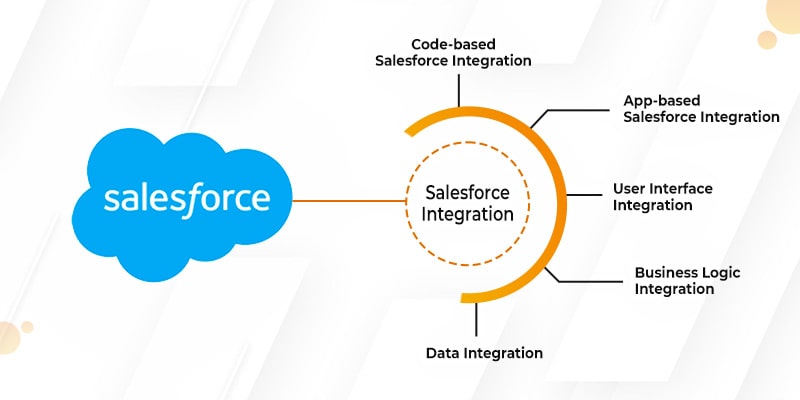Salesforce has helped organizations in handling their customer databases for over two decades. This means the technology has been in the domain for a considerable time.
This technology is prominent because it enables users with the right mix of personalization and automation to tailor the services to the client’s requirements. Even if your business demands to extend the functionalities of CRM and merge it with other platforms, Salesforce integration comes into the picture.
As a company offering Salesforce Development Services in USA, we want to highlight all about Salesforce Integration. Whether you’re new to the business world or already are an established business, the article will benefit both. Let’s first start by understanding what Salesforce Integration is.
What is Salesforce Integration?
Salesforce’s primary purpose is to offer users a unified experience. Salesforce integration is merging the data and functionality of Salesforce with another application. Doing so enables any team with a mix of features from both platforms. Salesforce users face the issue of reconciling data between two platforms and switching them when performing certain activities. Salesforce Integration relieves you from this issue by offering a centralized platform to work on.
Why do Businesses Prefer Salesforces?

This technology is still used by numerous companies across the globe as it helps them be more effective particularly in the areas of CRM (Customer Relationship Management) and remote workforce. While customers and employees are two of the strongest pillars of a successful business, companies flock toward Salesforce.
Now that we know what Salesforce Integration is, let’s look at two major approaches to carry out the process of Salesforce integration.
Code-based Salesforce Integration
One can carry out Salesforce integration even with the help of a programming language instead of using dedicated applications. Apex is among the most prominent programming languages used for code-based salesforce integration. Since the syntax of this language is similar to Java, you will get many developers to code for you.
A few benefits of carrying out code-based Salesforce integration with Apex language are:
- If offers built-in support for Salesforce lightning platform
- It is apt for different API versions
- It is easy to understand and simple to use
If you want to know more about this approach, take Salesforce Integration consulting from a well-known company offering development services like ours. Let us look at another Salesforce Integration approach: App-based.
App-based Salesforce Integration
As per the name, app-based Salesforce integration is carried out with dedicated applications. These apps enable users to integrate data between two applications and build a unified platform with a few clicks. If you need to integrate your Salesforce CEM with other applications, you will need a robust integration platform that lets seamless transfer of data between two applications. There are some more prominent third-party apps that enable effective Salesforce integration like Jitterbit and Zapier and many others.
While these two are the most used approaches to integrate Salesforce in your system, there are several others. We will have a look at these approaches. Salesforce integration can be done for varying layers within your CRM platforms like user interface, data, and business logic.
User Interface Integration
Through this integration, users are permitted to enter different applications via a single unified platform. The approach used here is similar to that of Facebook wherein different application vendors are allowed to post content on a single platform. This is one of the most crucial integration types since users in companies need to traverse through different applications from a single platform.
Business Logic Integration
Business logic integration involves using Apex Web Services for handling inbound and outbound business logic across different applications. The aim here is to accomplish end-to-end business processes. When an application has a business logic integrated, it lets users work efficiently with large amounts of data.
Data Integration
Through data integration, you can use SOAP or REST APIs(types of APIs) to allow a centralized application in your organization. It acts as a key source of a specific business object. This type of integration does not require any coding and it can’t be used to implement any type of custom logic. Data integration, unlike business logic, is fixed.
Salesforce Integration Checklist
Salesforce has an integration checklist for all companies/businesses wanting to integrate its services. Before moving ahead with Salesforce integration, ensure you adhere to this checklist for a seamless integration process. You can consult a Salesforce expert if you need to be certain of adhering to this checklist.
Extensive Implementation Planning
The most significant part of Salesforce Integration is to develop an extensive implementation plan. Just how any other project requires you to create a project timeline to clearly define the objectives of the project, so does Salesforce integration.
Ensure you list down all the technical requirements required for Salesforce integration and the objectives you want to achieve. Also ensure you’re thoroughly aware of the Salesforce integration guidelines and practices while preparing the plan. If you can afford, it’s best to take professional help with Salesforce integration.
Wrapping Up
Hopefully, the blog helped you know all about Salesforce Integration and how to do it. If you’re looking for Salesforce Integration services in USA, feel free to contact us. We offer consulting, development and post-development services for your mobile app or website. All we need are your business and budget requirements!

